Research - (2020) Advances in Dental Surgery
Children
Ashwin Kumar and Jessy P*
*Correspondence: Jessy P, Department of Pedodontics, Saveetha Dental College, Saveetha Institute of medical and Technical Sciences, Saveetha University, Chennai, India, Email:
Abstract
Flavor is the sensory impression of food or other substances and is determined primarily by the chemical senses of taste and smell. The "trigeminal senses", which detect chemical irritants in the mouth and throat, as well as temperature and texture, are also important to the overall gestalt of flavor perception. The flavor of the food, as such, can be altered with natural or artificial flavorings which affect these senses. The aim of the study is to assess the preference of children towards flavoured materials and armamentarium used in Pediatric dentistry. The study was carried out in the Department of Pediatric and Preventive Dentistry, Saveetha Dental College and Hospital, Chennai, India. Sixty children reporting to the OP along with their parents, with an informed consent formed the sample for this study. Physical demonstration of flavored and unflavored materials to the participants was done. Each item preference was marked. The obtained data was entered in excel spreadsheet and analyzed using SPSS software version 20.0.Chi square test was performed and Level of significance was set at p<0.05.The result proved that the children's preference was more towards the flavoured materials and armamentarium compared to unflavoured materials with the exception of alginate where most of them preferred unflavoured with the statistical significant difference p<0.05. Within the limits of the current study, it can be concluded that the preference towards the flavoured dental armamentarium is maximum where alginate on exception where unflavoured materials are preferred due to the gag reflex that the patients naturally have. Further extensive research on a wider variety of flavoured dental materials can be done on a larger population. As the literature says flavours are directly proportional to emotions of a child ,it can be effectively adjunct in managing behaviour of a child.
Keywords
Flavours, Dental materials, Unflavoured, Armamentarium, Children, Preference
Introduction
Flavor defines the sensory impression of food or other substances of nature, which is determined primarily by the chemical senses of taste and smell. The "trigeminal senses", which detect irritants in the mouth and throat, as well as temperature and texture, are also important to the overall flavor perception. The flavor of the food, as such, can be altered with natural or artificial flavorings which affect these senses. There are different types of flavouring substances. Most of the flavoring substances are naturally obtained in their natural state from plant or animal raw materials, or by their physical, microbiological, or enzymatic processes. Synthesised natural flavouring substance is chemically identical to a substance found in nature. Artificial flavors are synthesized one that are not identified in any natural products.
Pain is stated as “an emotional, unpleasant condition involving psychosomatic and psychophysiological reaction towards realistic external threats such as anxiety, apprehension and mobilization of alarmed responses” [1,2]. It is one of the important primary emotions acquired as soon as after the birth to protect the individual from any harm or self-destruction. Most fears evident in children may have been acquired either objectively or subjectively. They don’t have any parental origin; objective fears are those which are produced by direct stimulation of sense organs. The fear that based on feelings and attitudes that have been suggested to the child by others mostly through parents or acquaintances are subjective fears [1]. Behaviour management involves non-pharmacological methods along with the pharmacological means [3]. In the present-daytrend, it is mostly towards using non-aversive techniques such as audiovisual distraction which has also emerged as a phenomenally successful technique for managing children in a dental clinic. Today dental and oral care products are available in a variety of flavours. Though, flavouring can be a marketing strategy, they do carry a benefit on oral/dental tissues. Thus, it is important for the dental health team to advise the right flavour of products which is therapeutic. Flavours are especially important in a child acceptance as its component principally impresses the taste and smell senses. The anxiety of patients undergoing dental treatment can be reduced by colorful and flavoured materials which can be extremely relaxing for fearful patients. Therefore, the motto of the present study was to compare the efficacy of flavoured dental materials towards the clinical management and their preference [4]. Our team is passionate about child care, we have published numerous high quality articles in this domain over the past 3 years [5-23]. With this inspiration we planned to pursue research to assess the children’s preference towards flavoured materials and armamentarium in paediatric dentistry.
Materials and Methods
The study was carried out in the Department of Pediatric and Preventive Dentistry, Saveetha Dental College and Hospital, Chennai, India. Sixty children in the age group of 6 to 16 years reporting to the OP along with their parents, with an informed consent formed the sample for this study. The study protocol was approved by the Institutional Review Board with the ethical number (SDC/SIHEC/2020/ DIASDATA/0619-0320). Convenient sampling was done.
Inclusion criteria
Children who had a physical status of ASA 1 or 2.
Children who were able to communicate in english or local language were included.
Only children whose parental consent were obtained were included.
Exclusion criteria
Children with cognitive disability.
Children who are medically compromised especially neurological and olfactory impairments.
Adults were excluded who are beyond 16years of age.
Uncooperative children were eliminated.
Children allergic to fragrance and flavours were eliminated from the present study.
The preference of children for the various flavoured and unflavoured dental materials and armamentarium such as Rubber dam, Suction tip. Alginate, Local anesthetic (LA) gel, Examination gloves, Fluoride gel and Dental floss was evaluated by doing physical demonstration for the children (Figure 1). Each child was demonstrated for both flavoured and unflavoured material and their choice of the material was noted. Patient age, gender, preference to each material was marked manually and the obtained data was entered in MS excel spreadsheet and imported to Statistical analysis using SPSS software version 20.0.Chi square test. Level of significance set at p<0.05.
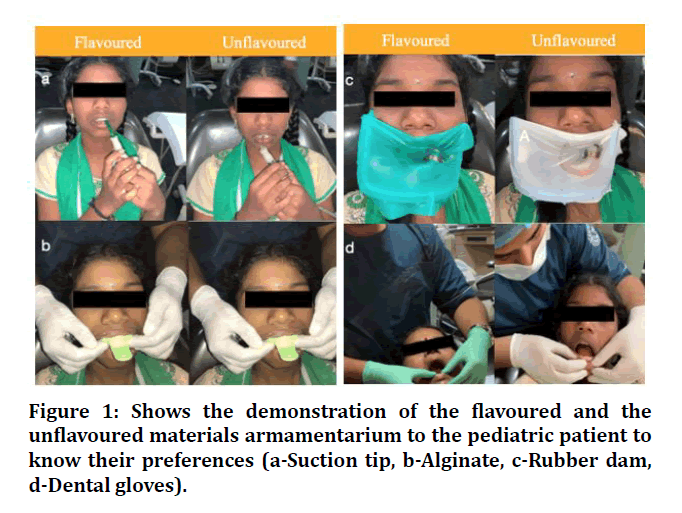
Figure 1: Shows the demonstration of the flavoured and the unflavoured materials armamentarium to the pediatric patient to know their preferences (a-Suction tip, b-Alginate, c-Rubber dam, d-Dental gloves).
Results and Discussion
The preference of children towards various flavoured and unflavoured dental materials and armamentarium were tabulated and analyzed. The results proved that the children's preference was more towards the flavoured materials and armamentarium. The study population presents Males (46.67%) and females (53.33%) (Figure 2).
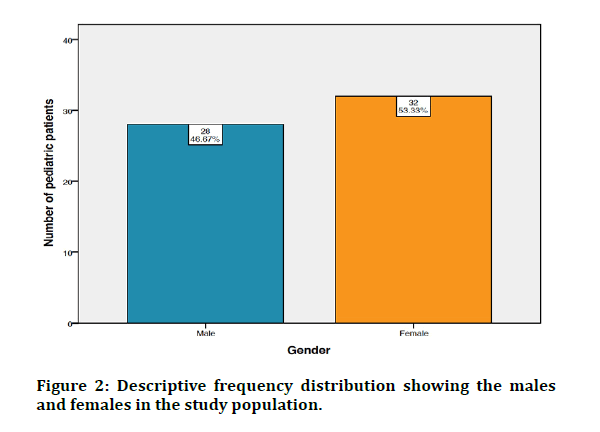
Figure 2: Descriptive frequency distribution showing the males and females in the study population.
The relation between the rubber dam and gender of the pediatric patients is represented in Figure 3. Where most of the patients in both male and female prefer flavoured which is 38.88% and 45% respectively, however chi square test p value is -0.793. p>0.05 statistically not significant. The relation between the suction tip and gender of the pediatric patients. Where most of the patients in both male and female prefer flavoured which is 38.33% and 43.33% respectively. Chi square test p value is 0.970. p>0.05 statistically not significant (Figure 4). The relation between the alginate and gender of the pediatric patients. Where most of the patients in both male and female prefer unflavoured which is 36.67% and 46.67% respectively, however chi square test p value is -0.353. p>0.05 statistically not significant (Figure 5). When comparing LA gel and gender of the pediatric patients, most of the patients in both male and female prefer flavoured which is 38.33% and 46.67% respectively. Chi square test p value is -0.084. p>0.05 statistically not significant (Figure 6). The relation between the gloves and gender of the pediatric patients is represented in Figure 7. Most of the patients in both male and female prefer flavoured which is 36.67% and 33.33% respectively. Chi square test P value is -0.380. p>0.05 statistically not significant. Comparing fluoride gel and dental floss (Figures 8 and 9) flavoured one was preferred by both males and females with p value 0.898 and p value is 0.275 respectively which was statistically not significant.
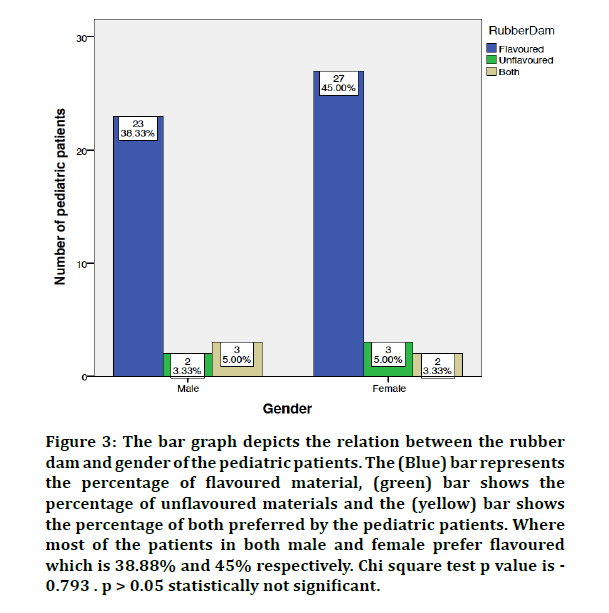
Figure 3: The bar graph depicts the relation between the rubber dam and gender of the pediatric patients. The (Blue) bar represents the percentage of flavoured material, (green) bar shows the percentage of unflavoured materials and the (yellow) bar shows the percentage of both preferred by the pediatric patients. Where most of the patients in both male and female prefer flavoured which is 38.88% and 45% respectively. Chi square test p value is - 0.793 . p > 0.05 statistically not significant.
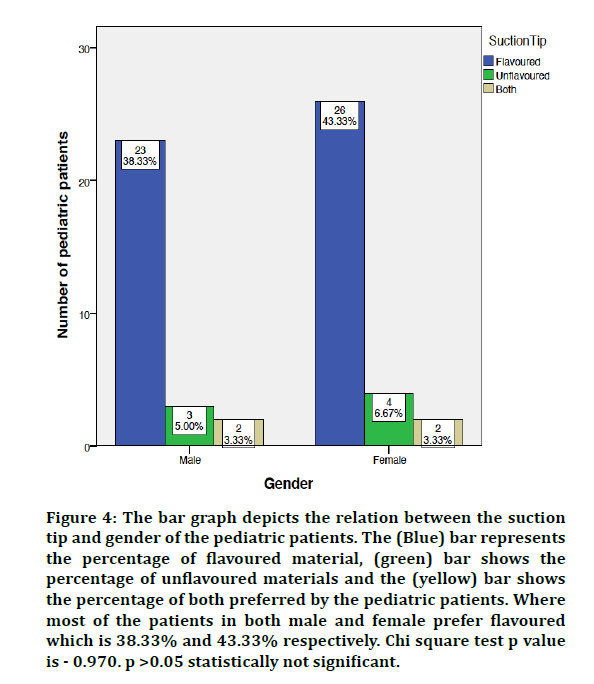
Figure 4: The bar graph depicts the relation between the suction tip and gender of the pediatric patients. The (Blue) bar represents the percentage of flavoured material, (green) bar shows the percentage of unflavoured materials and the (yellow) bar shows the percentage of both preferred by the pediatric patients. Where most of the patients in both male and female prefer flavoured which is 38.33% and 43.33% respectively. Chi square test p value is - 0.970. p >0.05 statistically not significant.
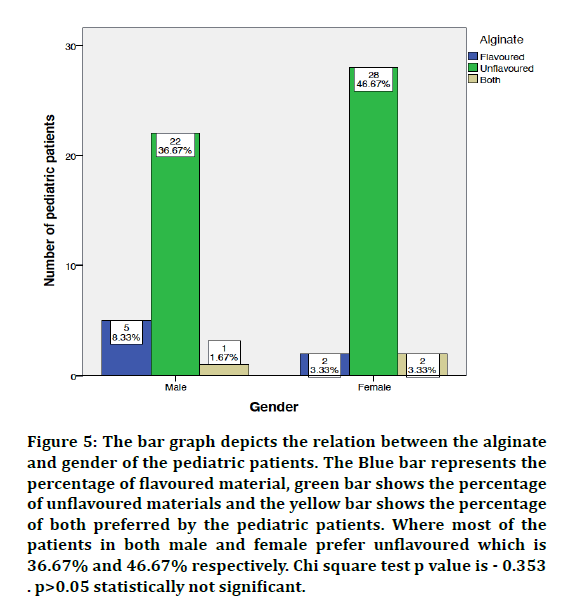
Figure 5: The bar graph depicts the relation between the alginate and gender of the pediatric patients. The Blue bar represents the percentage of flavoured material, green bar shows the percentage of unflavoured materials and the yellow bar shows the percentage of both preferred by the pediatric patients. Where most of the patients in both male and female prefer unflavoured which is 36.67% and 46.67% respectively. Chi square test p value is - 0.353 . p>0.05 statistically not significant.
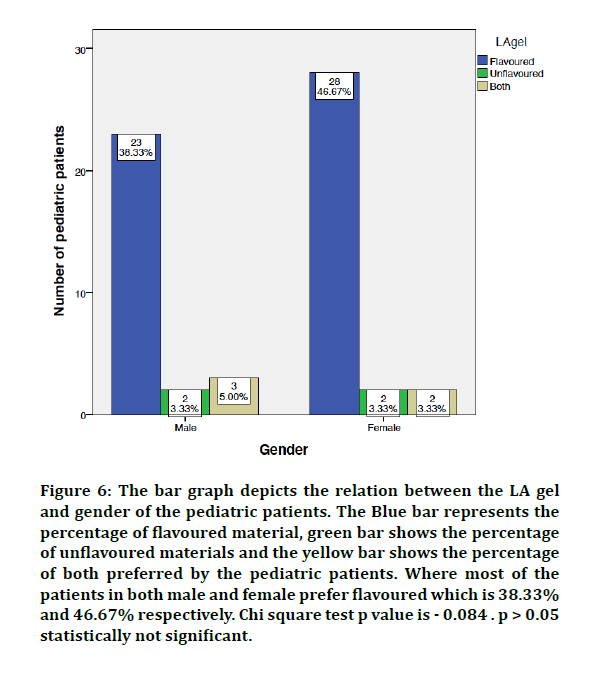
Figure 6: The bar graph depicts the relation between the LA gel and gender of the pediatric patients. The Blue bar represents the percentage of flavoured material, green bar shows the percentage of unflavoured materials and the yellow bar shows the percentage of both preferred by the pediatric patients. Where most of the patients in both male and female prefer flavoured which is 38.33% and 46.67% respectively. Chi square test p value is - 0.084 . p > 0.05 statistically not significant.
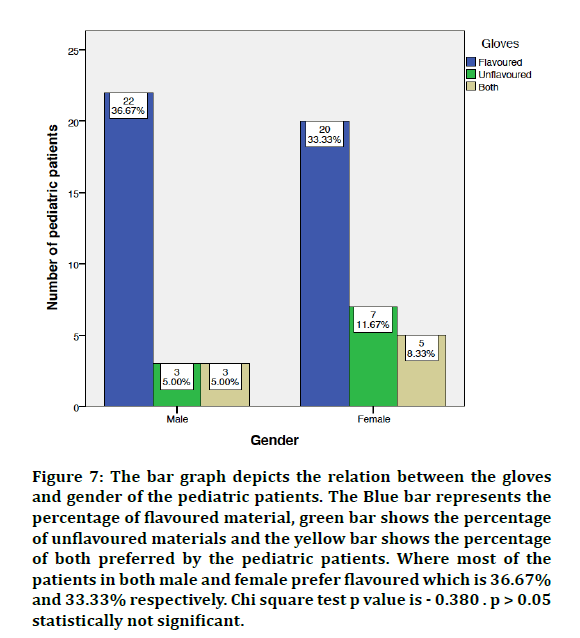
Figure 7: The bar graph depicts the relation between the gloves and gender of the pediatric patients. The Blue bar represents the percentage of flavoured material, green bar shows the percentage of unflavoured materials and the yellow bar shows the percentage of both preferred by the pediatric patients. Where most of the patients in both male and female prefer flavoured which is 36.67% and 33.33% respectively. Chi square test p value is - 0.380 . p > 0.05 statistically not significant.
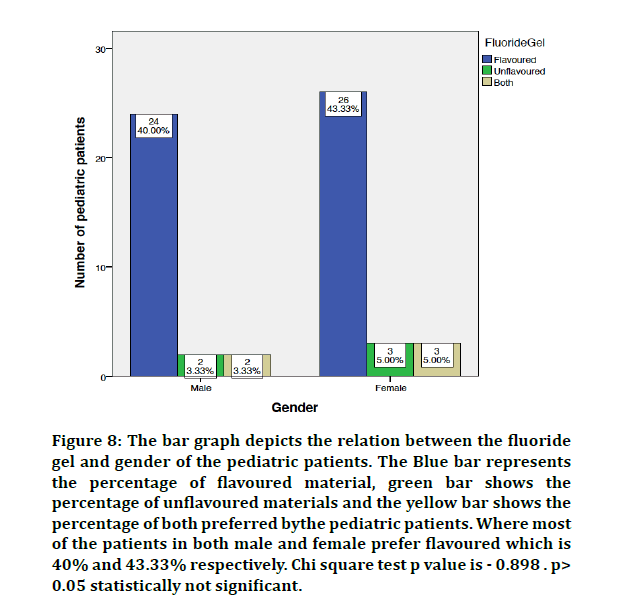
Figure 8: The bar graph depicts the relation between the fluoride gel and gender of the pediatric patients. The Blue bar represents the percentage of flavoured material, green bar shows the percentage of unflavoured materials and the yellow bar shows the percentage of both preferred bythe pediatric patients. Where most of the patients in both male and female prefer flavoured which is 40% and 43.33% respectively. Chi square test p value is - 0.898 . p> 0.05 statistically not significant.
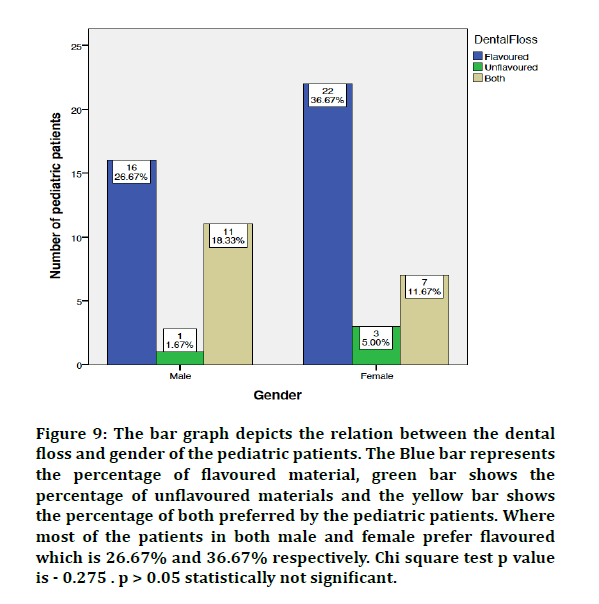
Figure 9: The bar graph depicts the relation between the dental floss and gender of the pediatric patients. The Blue bar represents the percentage of flavoured material, green bar shows the percentage of unflavoured materials and the yellow bar shows the percentage of both preferred by the pediatric patients. Where most of the patients in both male and female prefer flavoured which is 26.67% and 36.67% respectively. Chi square test p value is - 0.275 . p > 0.05 statistically not significant.
Discussing about the age of the child and dental materials and armamentarium, most of the patients in both male and female of age group 6 to10 years, 11-13 years, 14 to 16 years prefer flavoured armamentarium which is 28.33%, 30%, 25% respectively. Chi square test p value is -0.122. p>0.05 statistically not significant (Figure 10). Comparing suction tip with age group, all the age groups maximum preferred, flavoured material. Chi square test p value is - 0.685. p>0.05 statistically not significant (Figure 11). The relation between the alginate and age of the pediatric patients is represented in Figure 12, most of the patients in both male and female of age group 6 to 10 years, 11-13 years, 14 to 16 years prefer unflavoured armamentarium which is 21.67%, 36.67%, 25% respectively. Chi square test P value is -0.038. p<0.05 statistically significant. Comparing the LA gel, fluoride gel and dental floss (Figures 13-15) maximum children preferred towards flavoured materials with p value 0.409,0.096 and 0.093 respectively which of statistically not significant (p>0.05). The relation between the gloves and age of the pediatric patients is represented in Figure 16, the most of the patients in both male and female of age group 6 to 10 years, 11-13 years, 14 to 16 years prefer flavoured armamentarium which is 26.67%, 33.33%, 10.00% respectively. Chi square test p value is - 0.013 p < 0.05 which is statistically significant.
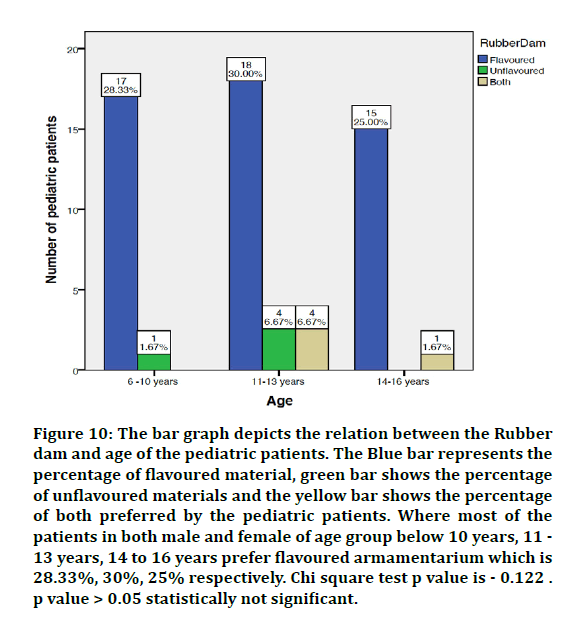
Figure 10: The bar graph depicts the relation between the Rubber dam and age of the pediatric patients. The Blue bar represents the percentage of flavoured material, green bar shows the percentage of unflavoured materials and the yellow bar shows the percentage of both preferred by the pediatric patients. Where most of the patients in both male and female of age group below 10 years, 11 - 13 years, 14 to 16 years prefer flavoured armamentarium which is 28.33%, 30%, 25% respectively. Chi square test p value is - 0.122 . p value > 0.05 statistically not significant.

Figure 11: The bar graph depicts the relation between the suction tip and age of the pediatric patients. The Blue bar represents the percentage of flavoured material, green bar shows the percentage of unflavoured materials and the yellow bar shows the percentage of both preferred by the pediatric patients. Where most of the patients in both male and female of age group below 10 years, 11 - 13 years, 14 to 16 years prefer flavoured armamentarium which is 26.67%, 35%, 12% respectively. Chi square test P value is -0.685. p>0.05 statistically not significant.
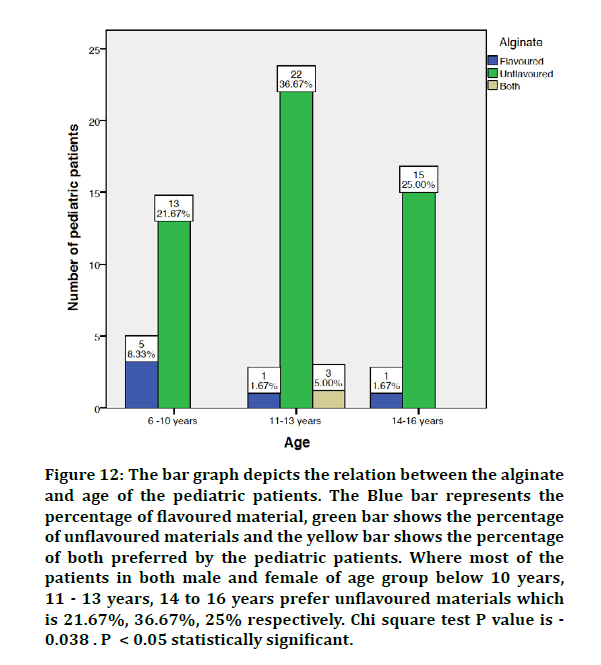
Figure 12: The bar graph depicts the relation between the alginate and age of the pediatric patients. The Blue bar represents the percentage of flavoured material, green bar shows the percentage of unflavoured materials and the yellow bar shows the percentage of both preferred by the pediatric patients. Where most of the patients in both male and female of age group below 10 years, 11 - 13 years, 14 to 16 years prefer unflavoured materials which is 21.67%, 36.67%, 25% respectively. Chi square test P value is - 0.038 . P < 0.05 statistically significant.
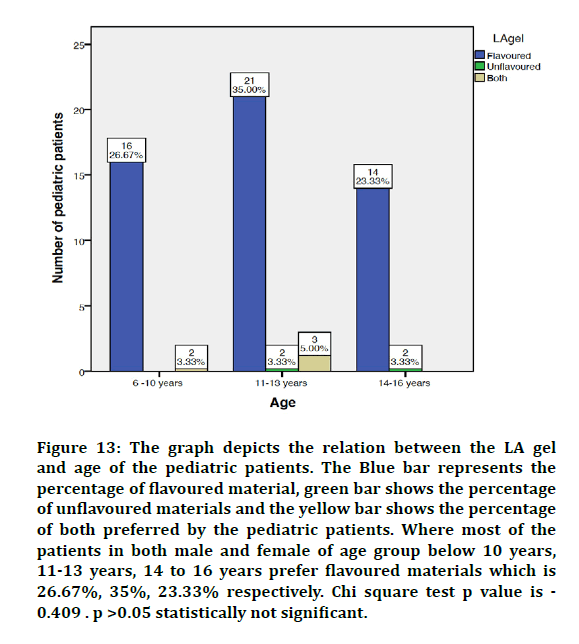
Figure 13: The graph depicts the relation between the LA gel and age of the pediatric patients. The Blue bar represents the percentage of flavoured material, green bar shows the percentage of unflavoured materials and the yellow bar shows the percentage of both preferred by the pediatric patients. Where most of the patients in both male and female of age group below 10 years, 11-13 years, 14 to 16 years prefer flavoured materials which is 26.67%, 35%, 23.33% respectively. Chi square test p value is - 0.409 . p >0.05 statistically not significant.
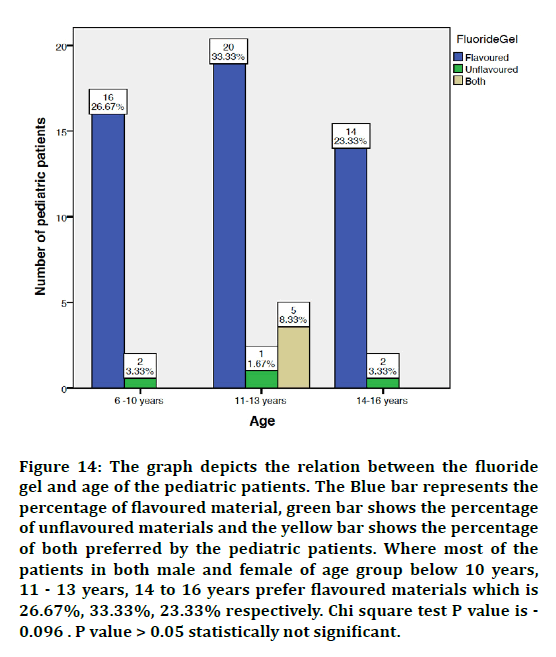
Figure 14: The graph depicts the relation between the fluoride gel and age of the pediatric patients. The Blue bar represents the percentage of flavoured material, green bar shows the percentage of unflavoured materials and the yellow bar shows the percentage of both preferred by the pediatric patients. Where most of the patients in both male and female of age group below 10 years, 11 - 13 years, 14 to 16 years prefer flavoured materials which is 26.67%, 33.33%, 23.33% respectively. Chi square test P value is - 0.096 . P value > 0.05 statistically not significant.
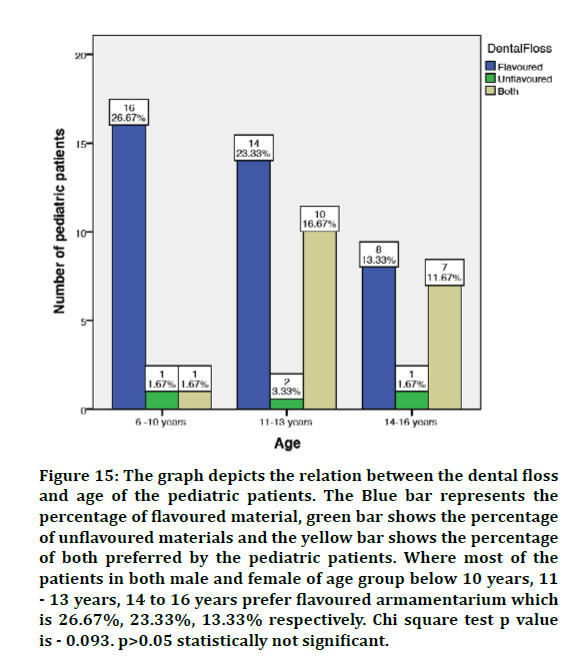
Figure 15: The graph depicts the relation between the dental floss and age of the pediatric patients. The Blue bar represents the percentage of flavoured material, green bar shows the percentage of unflavoured materials and the yellow bar shows the percentage of both preferred by the pediatric patients. Where most of the patients in both male and female of age group below 10 years, 11 - 13 years, 14 to 16 years prefer flavoured armamentarium which is 26.67%, 23.33%, 13.33% respectively. Chi square test p value is - 0.093. p>0.05 statistically not significant.
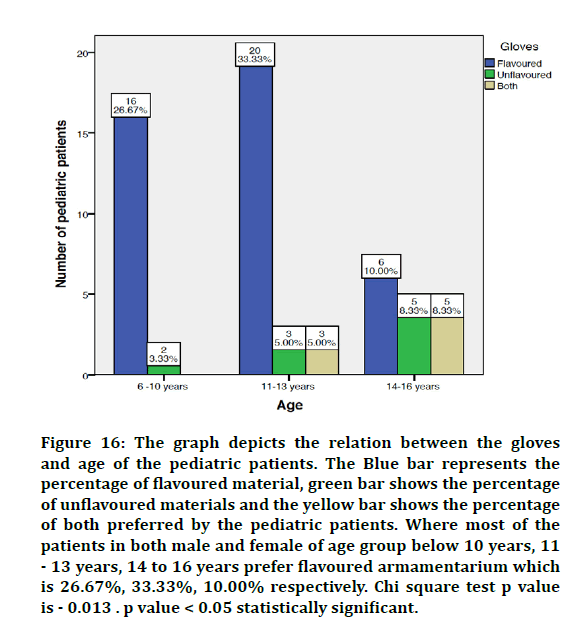
Figure 16: The graph depicts the relation between the gloves and age of the pediatric patients. The Blue bar represents the percentage of flavoured material, green bar shows the percentage of unflavoured materials and the yellow bar shows the percentage of both preferred by the pediatric patients. Where most of the patients in both male and female of age group below 10 years, 11 - 13 years, 14 to 16 years prefer flavoured armamentarium which is 26.67%, 33.33%, 10.00% respectively. Chi square test p value is - 0.013 . p value < 0.05 statistically significant.
The above results proved that maximum individuals preferred flavoured materials with the exception being alginate. As the literature says flavours are directly proportional to emotions of a child, it can be effectively adjunct in managing behaviour of a child. While using a flavoured alginate patients showed more gag reflex compared to the unflavoured which was preferred by most of the patients. p<0.05 which is statistically significant. In the present day, most of the dental and oral health care products are available in different flavors. Thus, it is necessary for the dentist to use and advise on the right flavor of products.In a child’s acceptance, flavors are especially important as its component principally impresses the taste and smell senses which helps them to cooperate during a dental procedure [24,25].
Chewing gums are made of natural or synthetic materials. The composition of chewing gum consists of gum base, small amounts of preservatives, sweetening, flavoring, and aromatic agents [4]. Basically, there are two types of sweeteners present: carbohydrates and non-carbohydrate sweeteners. Polyols are low-calorie non carbohydrate sweeteners predominantly. Frequently used polyols are sorbitol, which is hexatol, and xylitol is a pentatol. Hypothesized that pentatols are more effective than hexatols in preventing caries. When a alginate impression is taken for a pediatric patient it should be taken properly in the first try to reduce the anxiety of the patient which on failing the child will be unwilling for the second impression because of multiple factors which was overcome a comfortable environment, appropriate selection of impression trays without alginate overloading, the use of fast setting unflavored alginate, and correct upright positioning of the patient [26]. Many authors agree on the psychological factors involved in gagging while using flavoured impression material is more [27]. Where in the current study flavoured alginate was not accepted by any of the patients and showed better preference on use of the unflavoured material where more of a cooperative nature of the patient was observed. Topical anaesthetics always have a drawback of unpleasant taste, which on availability of various flavoured topical anaesthetics this condition has been ruled out and they have become more acceptable to children. Continuous research has been conducted on methods to evade the painful experience of anesthetic injection and that it becomes more comfortable to the pediatric patients. Children have their own preferences over the choice of topical agent in terms of flavors and the way how to use the agent that is gel or spray. The pain perception for various topical agents may also vary hence it needs to be evaluated as to which agent is the most acceptable and efficacious in case of children [28]. Where as per the current study all the pediatric patients only preferred flavoured topical anaesthetics.
In the category of demonstration related to the use of flavored materials, most of the patients preferred the use of flavored material. Regarding flavoured armamentarium all children such as gloves, rubber dam sheets, and dental floss, most preferred flavoured. In the preference use of flavored dental materials, most of the children preferred the use of flavored materials except for alginate impression material where children preferred a non-flavored material and in some cases both. This possibly could be because the strong smell of the flavor could add to a child’s natural gag reflex while using flavoured alginate [29,30]. Use of flavors is important in dentistry, due to the well-known fact that dental flavors provide taste benefits and freshen breath, mainly by masking the scent primarily by chemical mechanical cleaning or by activating antimicrobial systems by inhibiting bacterial sulfide compound production. It is also noted that flavonoids and the related compounds added for flavors in various agents have therapeutic benefits also, i.e., anti-inflammatory, antifungal, bacteriostatic, antithrombotic, antioxidant, and sometimes immunostimulant action [31,32]. Also, inputs received through the sensory systems, individually or together, can produce emotion and influence cognition. Also, odors influence autonomic responses, for example, pleasant and novel odors can decrease heart rate [33,34]. Also, overall, flavored material was favored possibly because of the feeling freshness and taste benefits of it.
Conclusion
Within the limits of the current study, it was seen that the preference towards the flavoured dental materials and armamentarium was maximum with alginate on exception where unflavoured was preferred by most of the children which might be due to strong smell of the flavor could add to a child’s natural gag reflex. As the literature says flavours are directly proportional to emotions of a child, it can be effective adjunct in managing behaviour of a child, further extensive research on a wider variety of flavoured dental materials is required on a larger scale.
Acknowledgement
Nil.
Conflict of Interest
Authors have no conflict of interest.
References
- Agarwal N, Dhawan J, Kumar D, et al. Effectiveness of two topical anaesthetic agents used along with audio visual aids in paediatric dental patients. J Clin Diagnostic Res 2017; 11:ZC80–ZC83.
- Singh S, Ali FM, Nazirkar G, et al. Gag-etiology and its skillfull management–A review. Evol Med Dent Sci 2013; 11:1509.
- Bågesund M, Tabrizi P. Lidocaine 20% patch vs lidocaine 5% gel for topical anaesthesia of oral mucosa. Int J Paediat Dent 2008; 18:452–460.
- Bradshaw DJ, Perring KD, Cawkill PM. Creation of oral care flavours to deliver breath‐freshening benefits. Oral Disease 2005; 11:75-79.
- Cugati N. Is flavor component in dental product therapeutic? Dent Res J 2012; 9:119–120.
- Deepika A, Chandrasekhar Rao R, Vinay C, et al. Effectiveness of two flavored topical anesthetic agents in reducing injection pain in children: A comparative study. J Clin Pediatr Dent 2012; 37:15–18.
- Finn SB, Akin J. Clinical pedodontics. WB Saunders company 1973.
- Fletcher M, Wilson DA. Ontogeny of odor discrimination: A method to assess novel odor discrimination in neonatal rats. Physiol Behavior 2001; 74:589–593.
- Giddon DB, Quadland M, Rachwall PC, et al. Development of a method for comparing topical anesthetics in different application and dosage forms. J Oral Therapeut Pharmacol 1968; 4:270–274.
- Govindaraju L, Jeevanandan G, Subramanian EMG. Comparison of quality of obturation and instrumentation time using hand files and two rotary file systems in primary molars: A single-blinded randomized controlled trial. Euro J Dent 2017; 11:376–379.
- Govindaraju L, Jeevanandan G, Subramanian EMG. Knowledge and practice of rotary instrumentation in primary teeth among Indian dentists: A questionnaire survey. J Int Oral Health 2017; 9:45.
- Hattab FN, Al-Omari MA, Al-Dwairi ZN. (1999) Management of a patient’s gag reflex in making an irreversible hydrocolloid impression’. J Prosthetic Dent 1999; 81:369.
- Jeevanandan G, Ganesh S, Arthilakshmi. Kedo file system for root canal preparation in primary teeth. Indian J Dent Res 2019; 30:622–624.
- Jeevanandan G, Govindaraju L. (2018) Clinical comparison of Kedo-S paediatric rotary files vs manual instrumentation for root canal preparation in primary molars: A double blinded randomized clinical trial. Eur Archives Paediatr Dent 2018; 19:273–278.
- Kanny G, Hatahet R, Moneret-Vautrin DA, et al. Allergy and intolerance to flavouring agents in atopic dermatitis in young children. Allergie Immunologie 1994; 26:204–206.
- Klassen JA, Liang Y, Tjosvold L, et al. Music for pain and anxiety in children undergoing medical procedures: a systematic review of randomized controlled trials. Ambulatory Pediatr 2008; 8: 117–128.
- Lehrner J, Eckersberger C, Walla P, et al. Ambient odor of orange in a dental office reduces anxiety and improves mood in female patients. Physiol Behavior 2000; 71:83–86.
- Nair M, Jeevanandan G, Vignesh R, et al. Comparative evaluation of post-operative pain after pulpectomy with k-files, kedo-s files and mtwo files in deciduous molars -A randomized clinical trial. Brazilian Dent Sci 2018; 21:411.
- Nandini VV, Venkatesh KV, Nair KC. Alginate impressions: A practical perspective. J Conservative Dent 2008; 11:37–41.
- Panchal V, Gurunathan D, Shanmugaavel AK. Smartphone application as an aid in determination of caries risk and prevention: A pilot study. European J Dent 2017; 11:469–474.
- Panchal V, Jeevanandan G, Subramanian E. Comparison of instrumentation time and obturation quality between hand K-file, H-files, and rotary Kedo-S in root canal treatment of primary teeth: A randomized controlled trial. J Indian Society Pedodont Preventive Dent 2019; 37:75–79.
- Panchal V, Jeevanandan G, Subramanian EMG. Comparison of post-operative pain after root canal instrumentation with hand K-files, H-files and rotary Kedo-S files in primary teeth: a randomised clinical trial. Europ Archives Paediat Dent 2019; 20:467–472.
- Ramadurai N, Gurunathan D, Samuel AV, et al. Effectiveness of 2% Articaine as an anesthetic agent in children: randomized controlled trial. Clin Oral Invest 2019; 23:3543–3550.
- Ramakrishnan M, Dhanalakshmi R, Subramanian EMG. Survival rate of different fixed posterior space maintainers used in paediatric dentistry-A systematic review. Saudi Dent J 2019; 31:165–172.
- Ravikumar D, Gurunathan D, Gayathri R, et al. DNA profiling of Streptococcus mutans in children with and without black tooth stains: A polymerase chain reaction analysis. Dent Res J 2018; 15:334.
- Dhanalakshmi Ravikumar SN, Ramakrishna M, Sharna N, et al. Evaluation of McNamara’s analysis in South Indian (Tamil Nadu) children between 8-12 years of age using lateral cephalograms. J Oral Biol Craniofacial Res 2019; 9:193–197.
- Ravikumar D, Jeevanandan G, Subramanian EMG. Evaluation of knowledge among general dentists in treatment of traumatic injuries in primary teeth: A cross-sectional questionnaire study. European J Dent 2017; 11:232–237.
- Ravindra V, Rekha V, Annamalai S, et al. A comparative evaluation between dermatoglyphic patterns and different terminal planes in primary dentition. J Clin Experiment Dent 2018; 10:e1149–e1154.
- Ravindra V, Rekha CV, Annamalai S, et al. A comparative evaluation between cheiloscopic patterns and the permanent molar relationships to predict the future malocclusions. J Clin Experiment Dent 2019; 11:e553–e557.
- Sakamoto T, Fukuda KI, Saita N, et al. Autonomic nervous activity of patients with gagging problems during dental mirror insertion. Special Care Dent 2016; 36:80–84.
- Samuel SR, Acharya S, Rao JC. School interventions-based prevention of early-childhood caries among 3-5-year-old children from very low socioeconomic status: Two-year randomized trial. J Public Health Dent 2020; 80:51–60.
- Subramanyam D, Gurunathan D, Gaayathri R, et al. Comparative evaluation of salivary malondialdehyde levels as a marker of lipid peroxidation in early childhood caries. European J Dent 2018; 12:67–70.
- Vignesh R, Ditto Sharmin C, Annamalai S, et al. Management of complicated crown-root fracture by extra-oral fragment reattachment and intentional reimplantation with 2 years review. Contemporary Clin Dent 2019; 10:397–401.
- Vishnu Prasad S, Kumar M, Ramakrishnan M, et al. Report on oral health status and treatment needs of 5-15 years old children with sensory deficits in Chennai, India. Special Care Dent 2018; 38:58–59.
Author Info
Ashwin Kumar and Jessy P*
Department of Pedodontics, Saveetha Dental College, Saveetha Institute of medical and Technical Sciences, Saveetha University, Chennai, IndiaCitation: Ashwin Kumar, Jessy P,Children’s Preference Towards Flavoured Materials and Armamentarium in Paediatric Dentistry, J Res Med Dent Sci, 2020, 8 (7): 103-110.
Received: 15-Sep-2020 Accepted: 15-Oct-2020 Published: 22-Oct-2020
